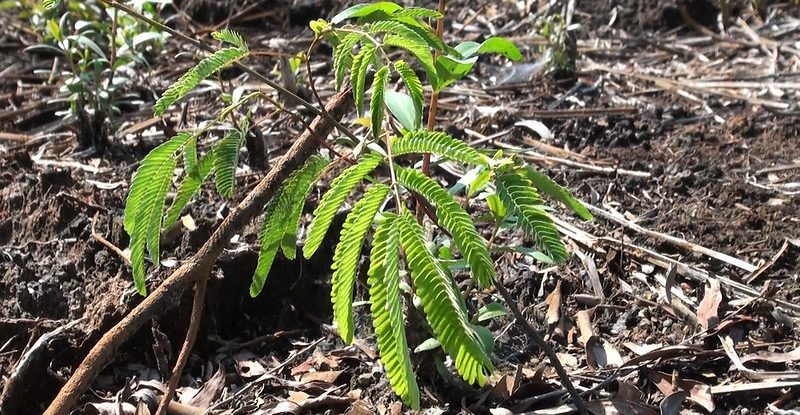
In anticipation of a projected scarcity of energy owing to reduction of sources of fossil-based energy, the government of Indonesia has moved quickly and boldly to create an enabling environment for production of biomass.
Following the creation of a National General Energy Plan, the National Development Planning Agency established a National Energy Policy, which aims for renewable energy to make up at least 23 percent of the national energy mix by 2025 and at least 31 percent by 2050.
Subsequently, the Ministry of Energy and Mineral Resources issued a decree accelerating the use of renewable energy by co-firing coal-fired powerplants with biomass; the state electricity company, PLN, mandated provision of biomass feedstock; and the Ministry of Environment and Forestry established a category called Hutan Energi or “energy forest” and a program of short-rotation energy plantations for a number of tree species, including Calliandra calothyrsus (Meissn.).
Several management approaches are used around the world for this type of plantation, such as “short rotation plantations” for harvesting and replanting, “short rotation coppices” for harvesting and producing coppices*, and “short rotation wood coppicing.” The latter is based on clear-cutting cycles, ranging 1 to 15 years, featuring fast-growing trees of uniform size with high-density spacing between the individual trees. This has been considered an ideal system for management of biomass because it not only provides regular, renewable feedstock but also a plethora of ecological services, including carbon sequestration.
To ensure maximum productivity, the optimum density of spacing between the trees, the timing of harvesting and the quality of the biomass produced needs to be well understood for each species of tree. Information about these factors has been lacking for Calliandra.
To fill these gaps in knowledge, researchers with the government’s Forest Research and Development Center under the Research, Development and Innovation Agency experimented with growing Calliandra in a 1-hectare research site in West Java Province. The Center for International Forestry Research and World Agroforestry (CIFOR-ICRAF) and the CGIAR Research Program on Forests, Trees and Agroforestry supported development of the published article.
The research site was divided into four plots with varied spacing between the individual trees: 1 × 1.5 m; 1.5 × 1.5 m; 2 × 1.5 m; and 2 × 2 m.
The team monitored the trees’ growth and yields at ages of 12, 18 and 24 months in each plot. Thirty trees were let grow to observe their growth rates and another 10 were cut at each of the three ages after planting. The trees were felled at 50 cm from the ground and the stumps left to regrow. A year after felling, the resultant coppices were measured then cut.
By way of comparison, the team measured both primary and coppiced wood for growth, productivity and calorific values, the latter being an important factor determining suitability for use in electricity generation.
“We found that the competition between trees strongly determined the growth and productivity of the primary wood,” said Enny Widyati, senior researcher with the Forest Research and Development Center and lead author of the team’s report that was published in the scientific journal, Forest Science and Technology, in February 2022.
Specifically, they discovered that the plot with the densest spacing had the lowest content for almost all types of nutrients, which led to fewer and smaller diameter stems and lower productivity of biomass.
They also found that productivity increased by up to 15 percent with coppicing. The optimum productivity of wood and the greatest economy came from coppiced stands with tree spacing of 2 × 2 m, harvested at 18 months-old.
This yielded an average amount of biomass per tree of 7.2 kg of primary wood and 8.22 kg of coppice wood.
The lignin content was about 22 percent and calorific value around 18,807 kJ, which fit the requirements of feedstock for generating electricity.
Harvesting at 24 months showed no significant increases in productivity, lignin content or calorific value.
The team recommended that for future Calliandra energy plantations, a density of 2,500 trees per hectare with initial harvesting conducted at 18 months was optimal. Subsequent harvesting of coppices can follow at every 12 months, which is when the quality of the wood is most similar to that of the primary wood. They also recommended that leaves and cut branches and trunks should be left on site to support development of soil organic matter, which provides nutrients and other benefits for growth.
“The implications are exciting,” said Himlal Baral, a co-author of the study and senior scientist with CIFOR-ICRAF, “especially if the Calliandra trees are established on degraded and marginal lands.”
While national and global interests and commitments for forest landscape restoration are increasing, success so far has been limited by a lack of solid business cases or financial viability.
“Sustainably managed energy plantations could be the solution,” said Baral.
* “Coppicing” is the practice of cutting back a young tree’s stem to near ground level. The tree then sprouts several new stems that can be harvested and then resprout, a cycle that can continue for the life-span of the tree. Only certain species are suitable for coppicing.
We want you to share Forests News content, which is licensed under Creative Commons Attribution-NonCommercial-ShareAlike 4.0 International (CC BY-NC-SA 4.0). This means you are free to redistribute our material for non-commercial purposes. All we ask is that you give Forests News appropriate credit and link to the original Forests News content, indicate if changes were made, and distribute your contributions under the same Creative Commons license. You must notify Forests News if you repost, reprint or reuse our materials by contacting forestsnews@cifor-icraf.org.